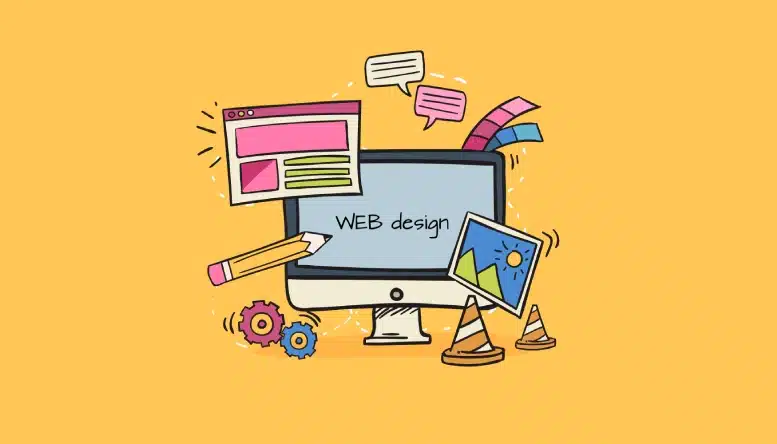Web Design London Ontario That Drives Online Visibility
Web Design London Ontario That Drives Online Visibility
Blog Article
Exactly How to Properly Integrate Looks and Functionality in Website Design
When creating a site, you require to strike a balance in between appearances and functionality. It's not nearly looking good; your layout ought to also serve a function and overview customers successfully. By concentrating on simplicity and user-friendly navigating, you can develop an engaging experience. Yet what elements genuinely improve usability while preserving visual appeal? Let's discover the key concepts that can lead to an unified mix of elegance and function.
Comprehending the Relevance of Appearances and Performance
Understanding the balance between appearances and performance is crucial for developing an efficient customer experience when you make a site. A visually appealing website grabs interest, but it's the functionality that keeps customers engaged. If your site looks great yet is difficult to navigate, visitors will promptly weary and leave.Consider your target market and what draws them in. You desire to create a layout that shows your brand name while making certain convenience of use. Structured layouts, instinctive navigation, and clear telephone calls to activity can enhance both aesthetics and capability.

Concepts of Effective Web Design
To create a reliable website design, you need to abide by a number of vital concepts that improve both customer experience and aesthetic allure. Focus on simpleness; a clean layout helps users browse conveniently. Utilize a constant color pattern and typography to maintain coherence throughout your website. This cultivates experience and trust.Next, ensure your layout is responsive. Users gain access to web sites on numerous devices, so your design should adjust effortlessly. Focus on aesthetic pecking order; highlight crucial aspects with positioning, shade, or dimension to assist customers' focus.Finally, incorporate enough white space. It protects against mess and makes material more digestible. Keep in mind, reliable web design equilibriums aesthetics and performance, so every design selection must offer an objective. By following these principles, you'll produce a site that's not only aesthetically attractive but also user-friendly, inevitably keeping site visitors involved and motivating them to return.
Prioritizing Individual Experience
When focusing on customer experience, you'll want to begin by understanding what your customers truly need. Simplifying navigating design can make a massive distinction in exactly how easily they discover what they're searching for. Additionally, enhancing visual hierarchy helps guide their interest to one of the most important components on your website.
Recognizing Individual Needs
Understanding customer needs is essential for developing an appealing internet experience that maintains visitors coming back. To achieve this, you have to determine the goals and preferences of your target audience. Beginning by conducting customer research, like meetings or studies, to gather understandings on what individuals worth most. When engaging with similar sites, pay focus to their pain factors and obstacles. This info permits you to customize your style, making certain functionality lines up with user assumptions. Furthermore, take into consideration developing customer personas that represent different segments of your target market, aiding you visualize their requirements throughout the layout process. When you prioritize understanding user requirements, you develop a website that not only looks great yet additionally delivers a seamless, pleasurable experience that promotes loyalty.
Streamlining Navigating Layout

Enhancing Aesthetic Power Structure
A solid aesthetic pecking order is vital in directing users through your website and guaranteeing they engage with vital web content. To accomplish this, use spacing, shade, and size strategically. Make important components like headings larger and bolder than body text, attracting interest right away. Use contrasting colors to highlight telephone calls to action, encouraging clicks. In addition, utilize ample white space to different sections, making material digestible and inviting.Consider the circulation of details; prepare aspects realistically, leading users' eyes from one factor to the next. Use aesthetic hints, like arrows or lines, to direct focus. By prioritizing aesthetic hierarchy, you boost user experience and raise the possibility of conversions, guaranteeing your site is both cosmetically pleasing and functionally efficient.
Shade Theory and Its Effect On Usability
While selecting the right colors for your internet site may feel like a minor detail, it greatly affects usability and individual experience. Shade affects exactly how individuals view have a peek at this website info and can prevent or boost navigation. For circumstances, contrasting colors can assist vital elements stick out, making it easier for visitors to discover what they need.Additionally, take into consideration the psychology of colors: blue commonly motivates trust, while red produces necessity. Recognizing your target market can lead your shade selections, assuring they reverberate well.Moreover, consistent shade plans help construct brand name identification, making your site more remarkable. Be cautious-- too many shades can bewilder customers. Adhere to a minimal scheme that enhances your material and preserves clarity.Incorporating availability is likewise vital; confirm your color combinations are pleasant for those with aesthetic impairments. By thoughtfully applying color theory, you'll improve functionality and create a more engaging customer experience.
Typography: Harmonizing Style and Readability
Color selections established the stage for your site, but typography plays a just as essential duty in improving user experience. You desire your message to interact clearly while additionally reflecting your brand's individuality. Begin by selecting typefaces that are not just eye-catching but likewise clear. Sans-serif fonts often function well for digital displays, as they're less complicated to review at different sizes.Maintain a hierarchy by using various font sizes and weights; this guides users via your material effortlessly. Consider line spacing and letter spacing; as well tight can discourage visitors, while too loosened can disrupt the circulation. Limit your typeface choices to 2 or three to keep the layout cohesive.Finally, always examine your typography throughout various devices and web browsers. What looks good on one display might not on an additional. Balancing design with readability warranties that your message resonates, maintaining your audience engaged and informed.
Receptive Layout: Making Aesthetics Work on All Devices
To guarantee your web site looks great on any type of tool, you'll require to accept responsive style concepts. This strategy guarantees your site adapts to numerous display dimensions, providing a suitable user experience. Start by utilizing liquid grids and adaptable photos that scale seamlessly. As opposed to taken care of measurements, go with percents and relative units, enabling your format to readjust dynamically.Next, apply media questions in your CSS. These allow you use different styles based on gadget characteristics, like screen width. In this manner, you can keep visual allure while assuring functionality.Don' t ignore touch targets; make specific buttons and links are easy to touch on smaller sized displays. Prioritize crucial web content, so customers can conveniently browse your site regardless of their device. By concentrating on these aspects, you'll produce an appealing, aesthetically appealing experience that fulfills the demands of all individuals, whether they're on a tablet, mobile phone, or desktop computer .
Conducting Usability Screening for Continual Renovation
To improve your web layout, you require to set clear usability objectives that straighten with individual needs. By performing individual tests, you can collect important responses on exactly how real individuals engage with your site. Assessing these results will help you make educated improvements and produce a more effective individual experience.
Specifying Use Goals
While visual appeals can attract individuals in, specifying use goals is crucial for ensuring their experience continues to be enjoyable and seamless. Begin by recognizing what you desire individuals to attain on your site (website design london Ontario). Consider their demands, tasks, and behaviors. Are they trying to find info, buying, or authorizing up for an e-newsletter? Establish clear benchmarks to gauge success, like job completion rates or time on job. Focus on user-friendly navigating, available web content, and receptive design to improve use. On a regular basis revisit these goals as individual assumptions evolve. By defining functionality goals, you develop a structure for assessing and enhancing your web site's efficiency. This concentrate on use not just improves individual contentment yet also reinforces the overall webpage efficiency of your style
Carrying Out Customer Examinations
Conducting customer examinations is crucial for refining your website and ensuring it satisfies your audience's demands. Start by identifying your target users and creating an examination strategy that details your purposes. Make use of a mix of qualitative and measurable techniques, such as surveys, interviews, and task-based monitorings, to gather detailed responses. Welcome participants to browse your website while you observe their communications and keep in mind any type of problems they experience. Encourage open discussion to record their thoughts and feelings about the layout and performance. Keep sessions short and concentrated, guaranteeing you cover essential areas without frustrating individuals. Make sure to record all findings, as this information will certainly be invaluable for making educated style decisions that improve both aesthetics and functionality.
Assessing Test Results
How can you properly examine the results of your functionality tests to drive continual improvement? Beginning by categorizing feedback into usual he has a good point themes. Search for patterns in individual behavior that highlight discomfort points or areas for improvement. Use quantitative information, like task conclusion prices and time on task, to gauge usability objectively. Don't neglect to think about qualitative understandings from customer remarks; they usually reveal underlying concerns that numbers can't reveal. Focus on the most impactful findings and produce actionable things for your style team. Keep in mind, it's regarding repeating-- apply modifications, then examination once again. This cycle of screening, evaluating, and refining assists you equilibrium aesthetics and performance, guaranteeing your site fulfills user needs effectively while preserving visual charm.
Often Asked Concerns
Just how Do I Select the Right Shade Palette for My Internet site?
To pick the ideal shade combination for your site, consider your brand name's individuality, target market, and psychological impact (website design london Ontario). Usage shade psychology, create harmony, and assurance readability. Test combinations to see what resonates finest with visitors
What Devices Can Assist With Website Design Visual Appeals and Performance?
You can utilize tools like Adobe XD, Figma, and Sketch to improve your web layout's looks and capability. These systems use user-friendly user interfaces, partnership functions, and pre-made design templates to improve your creative process and improve your layouts.
Just How Can I Integrate Animations Without Jeopardizing Functionality?
To integrate animations without jeopardizing functionality, prioritize subtle results that improve individual experience. Use CSS computer animations for smoother communications, guarantee fast tons times, and examination on different gadgets to keep efficiency while adding visual charm.
What Are Usual Errors to Avoid in Website Design Aesthetic Appeals?
When designing, prevent cluttered formats, bad color options, and inconsistent typefaces. Don't ignore mobile responsiveness, as it can alienate customers. Verify your design straightens with your brand, producing a smooth experience that involves visitors successfully.
How Frequently Should I Update My Website's Style for Optimal Appearances?
You ought to upgrade your site's layout every 1-2 years to keep up with trends and preserve ideal aesthetic appeals. Routinely restoring visuals assists involve site visitors and warranties your site stays appealing and straightforward. When you create an internet site, understanding the balance between looks and functionality is essential for creating a reliable customer experience. To create an effective internet layout, you require to adhere to a number of crucial concepts that enhance both individual experience and visual charm. Users access internet sites on numerous devices, so your layout needs to adjust effortlessly. When focusing on customer experience, you'll desire to start by understanding what your users really require. Begin by carrying out user research, like meetings or surveys, to collect insights on what individuals value most.
Report this page